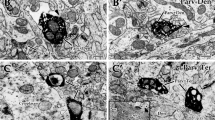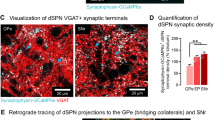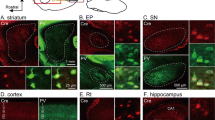Abstract
Previous studies have suggested that the neurokinin-1 receptor (NK-1R) expressing neurons in the globus pallidus (GP) receive substance P (SP), presumably released by axon collaterals of striatal direct neurons. However, the effect of SP on the GP remains unclear. In this study, we identified that the SP-responsive cells comprise a highly specific cell type in the GP with regard to immunofluorescence, electrophysiology, and projection properties. Morphologically, NK-1R-immunoreactive neurons occasionally co-expressed parvalbumin (PV) and/or Lim-homeobox 6 (Lhx6), but not Forkhead box protein P2 (FoxP2), which is mainly expressed by arkypallidal neurons. Retrograde tracing experiments also showed that some of GP neurons projecting to the subthalamic nucleus (namely prototypic neurons) expressed NK-1R as well as Lhx6 and/or PV, but not FoxP2. In vitro electrophysiological study revealed that, among 48 GP neurons, the SP agonist induced inward current in 21 neurons. The response was prevented by bath application of the NK-1R antagonist. Based on the firing properties, 92 recorded GP neurons were classified into three distinct types, i.e., CL1, 2, and 3. Interestingly, all the SP-responsive neurons were found to be in CL2 and CL3 types, but not in CL1. Moreover, active and passive membrane properties of the neurons in those clusters and immunofluorescent identification suggested that CL1 and CL2/3 could be considered as arkypallidal and prototypic neurons, respectively. Therefore, SP-responsive neurons were one of the populations of prototypic neurons based on both anatomical and electrophysiological results. Altogether, the striatal direct pathway neurons could affect the indirect pathway in the way of prototypic neurons, via the action of SP to NK-1R.








Similar content being viewed by others
References
Abdi A, Mallet N, Mohamed FY et al (2015) Prototypic and arkypallidal neurons in the dopamine-intact external globus pallidus. J Neurosci 35:6667–6688. doi:10.1523/JNEUROSCI.4662-14.2015
Albin RL, Young AB, Penney JB (1989) The functional anatomy of basal ganglia disorders. Trends Neurosci 12:366–375. doi:10.1016/0166-2236(89)90074-X
Alexander GE, Crutcher MD (1990) Functional architecture of basal ganglia circuits: neural substrates of parallel processing. Trends Neurosci 13:266–271. doi:10.1016/0166-2236(90)90107-L
Aosaki T, Kawaguchi Y (1996) Actions of substance P on rat neostriatal neurons in vitro. J Neurosci 16:5141–5153
Bevan MD, Booth P, Eaton S, Bolam JP (1998) Selective innervation of neostriatal interneurons by a subclass of neuron in the globus pallidus of the rat. J Neurosci 18:9438–9452
Bevan MD, Magill PJ, Terman D et al (2002) Move to the rhythm: oscillations in the subthalamic nucleus-external globus pallidus network. Trends Neurosci 25:525–531. doi:10.1016/S0166-2236(02)02235-X
Cazorla M, de Carvalho FD, Chohan MO et al (2014) Dopamine D2 receptors regulate the anatomical and functional balance of basal ganglia circuitry. Neuron 81:153–164. doi:10.1016/j.neuron.2013.10.041
Chen L, Cui Q-L, Yung W-H (2009) Neurokinin-1 receptor activation in globus pallidus. Front Neurosci 3:58. doi:10.3389/neuro.23.002.2009
Cooper AJ, Stanford IM (2000) Electrophysiological and morphological characteristics of three subtypes of rat globus pallidus neurone in vitro. J Physiol 527(Pt 2):291–304. doi:10.1111/j.1469-7793.2000.t01-1-00291.x
Cui QL, Yung WH, Xue Y, Chen L (2007) Substance P excites globus pallidus neurons in vivo. Eur J Neurosci 26:1853–1861. doi:10.1111/j.1460-9568.2007.05803.x
Cui G, Jun SB, Jin X et al (2013) Concurrent activation of striatal direct and indirect pathways during action initiation. Nature 494:238–242. doi:10.1038/nature11846
DeLong MR (1990) Primate models of movement disorders of basal ganglia origin. Trends Neurosci 13:281–285. doi:10.1016/0166-2236(90)90110-V
Dodson PD, Larvin JT, Duffell JM et al (2015) Distinct developmental origins manifest in the specialized encoding of movement by adult neurons of the external globus pallidus. Neuron 86:501–513. doi:10.1016/j.neuron.2015.03.007
Eid L, Parent A, Parent M (2016) Asynaptic feature and heterogeneous distribution of the cholinergic innervation of the globus pallidus in primates. Brain Struct Funct 221:1139–1155. doi:10.1007/s00429-014-0960-0
Elde R, Schalling M, Ceccatelli S et al (1990) Localization of neuropeptide receptor mRNA in rat brain: initial observations using probes for neurotensin and substance P receptors. Neurosci Lett 120:134–138. doi:10.1016/0304-3940(90)90187-E
Flandin P, Kimura S, Rubenstein JL (2010) The progenitor zone of the ventral medial ganglionic eminence requires Nk2–1 to generate most of the globus pallidus but few neocortical interneurons. J Neurosci 30:2812–2823. doi:10.1523/JNEUROSCI.4228-09.2010
Fujiyama F, Sohn J, Nakano T et al (2011) Exclusive and common targets of neostriatofugal projections of rat striosome neurons: a single neuron-tracing study using a viral vector. Eur J Neurosci 33:668–677. doi:10.1111/j.1460-9568.2010.07564.x
Fujiyama F, Nakano T, Matsuda W et al (2015) A single-neuron tracing study of arkypallidal and prototypic neurons in healthy rats. Brain Struct Funct. doi:10.1007/s00429-015-1152-2
Furuta T, Koyano K, Tomioka R et al (2004) GABAergic basal forebrain neurons that express receptor for neurokinin B and send axons to the cerebral cortex. J Comp Neurol 473:43–58. doi:10.1002/cne.20087
Futami T, Hatanaka Y, Matsushita K, Furuya S (1998) Expression of substance P receptor in the substantia nigra. Mol Brain Res 54:183–198
Gerfen CR (1991) Substance P (neurokinin-1) receptor mRNA is selectively expressed in cholinergic neurons in the striatum and basal forebrain. Brain Res 556:165–170. doi:10.1016/0006-8993(91)90563-B
Gittis AH, Berke JD, Bevan MD et al (2014) New roles for the external globus pallidus in basal ganglia circuits and behavior. J Neurosci 34:15178–15183. doi:10.1523/JNEUROSCI.3252-14.2014
Gomez-Gallego M, Fernandez-Villalba E, Fernandez-Barreiro A, Herrero MT (2007) Changes in the neuronal activity in the pedunculopontine nucleus in chronic MPTP-treated primates: an in situ hybridization study of cytochrome oxidase subunit I, choline acetyl transferase and substance P mRNA expression. J Neural Transm 114:319–326. doi:10.1007/s00702-006-0547-x
Graybiel AM (1990) Neurotransmitters and neuromodulators in the basal ganglia. Trends Neurosci 13:244–254. doi:10.1016/0166-2236(90)90104-I
Hama H, Hioki H, Namiki K et al (2015) ScaleS: an optical clearing palette for biological imaging. Nat Neurosci 18:1518–1529. doi:10.1038/nn.4107
Hernández VM, Hegeman DJ, Cui Q et al (2015) Parvalbumin+ neurons and Npas1+ neurons are distinct neuron classes in the mouse external globus pallidus. J Neurosci 35:11830–11847. doi:10.1523/JNEUROSCI.4672-14.2015
Hoover BR, Marshall JF (2002) Further characterization of preproenkephalin mRNA-containing cells in the rodent globus pallidus. Neuroscience 111:111–125. doi:10.1016/S0306-4522(01)00565-6
Houk JC, Bastianen C, Fansler D et al (2007) Action selection and refinement in subcortical loops through basal ganglia and cerebellum. Philos Trans R Soc Lond B Biol Sci 362:1573–1583. doi:10.1098/rstb.2007.2063
Isomura Y, Takekawa T, Harukuni R et al (2013) Reward-modulated motor information in identified striatum neurons. J Neurosci 33:10209–10220. doi:10.1523/JNEUROSCI.0381-13.2013
Jakab RL, Goldman-Rakic P (1996) Presynaptic and postsynaptic subcellular localization of substance P receptor immunoreactivity in the neostriatum of the rat and rhesus monkey (Macaca mulatta). J Comp Neurol 369:125–136. doi:10.1002/(SICI)1096-9861(19960520)369:1<125:AID-CNE9>3.0.CO;2-5
Kameda H, Hioki H, Tanaka YH et al (2012) Parvalbumin-producing cortical interneurons receive inhibitory inputs on proximal portions and cortical excitatory inputs on distal dendrites. Eur J Neurosci 35:838–854. doi:10.1111/j.1460-9568.2012.08027.x
Kawaguchi Y, Wilson CJ, Emson PC (1990) Projection subtypes of rat neostriatal matrix cells revealed by intracellular injection of biocytin. J Neurosci 10:3421–3438. http://www.jneurosci.org/content/10/10/3421
Kita H (2007) Globus pallidus external segment. Prog Brain Res 160:111–133
Kita H, Kitai ST (1994) The morphology of globus pallidus projection neurons in the rat: an intracellular staining study. Brain Res 636:308–319. doi:10.1016/0006-8993(94)91030-8
Lee T, Kaneko T, Taki K, Mizuno N (1997) Preprodynorphin-, preproenkephalin-, and preprotachykinin-expressing neurons in the rat neostriatum: an analysis by immunocytochemistry and retrograde tracing. J Comp Neurol 386:229–244. doi:10.1002/(SICI)1096-9861(19970922)386:2<229:AID-CNE5>3.0.CO;2-3
Lessard A, Pickel VM (2005) Subcellular distribution of and plasticity of neurokinin-1 receptors in the rat substantia nigra and ventral tegmental area. Neurosci 135:1309–1323. doi:10.1016/j.neuroscience.2005.07.025
Lévesque M, Parent A (2005) The striatofugal fiber system in primates: a reevaluation of its organization based on single-axon tracing studies. Proc Natl Acad Sci USA 102:11888–11893. doi:10.1073/pnas.0502710102
Lévesque M, Bédard A, Cossette M, Parent A (2003) Novel aspects of the chemical anatomy of the striatum and its efferents projections. J Chem Neuroanat 26:271–281. doi:10.1016/j.jchemneu.2003.07.001
Lévesque M, Parent R, Parent A (2006) Cellular and subcellular localization of neurokinin-1 and neurokinin-3 receptors in primate globus pallidus. Eur J Neurosci 23:2760–2772. doi:10.1111/j.1460-9568.2006.04800.x
Lévesque M, Wallman MJ, Parent R, Sík A, Parent A (2007) Neurokinin-1 and neurokinin-3 receptors in primate substantia nigra. Neurosci Res 57:362–371. doi:10.1016/j.neures.2006.11.002
Mallet N, Micklem BR, Henny P et al (2012) Dichotomous organization of the external globus pallidus. Neuron 74:1075–1086. doi:10.1016/j.neuron.2012.04.027
Mallet N, Schmidt R, Leventhal D et al (2016) Arkypallidal cells send a stop signal to striatum. Neuron 89:308–316. doi:10.1016/j.neuron.2015.12.017
Mantyh PW, Hunt SP, Maggio JE (1984) Substance P receptors: localization by light microscopic autoradiography in rat brain using [3H]SP as the radioligand. Brain Res 307:147–165. doi:10.1016/0006-8993(84)90470-0
Mastro KJ, Bouchard RS, Holt HK, Gittis AH (2014) Transgenic mouse lines subdivide external segment of the globus pallidus (GPe) neurons and reveal distinct GPe output pathways. J Neurosci 34:2087–2099. doi:10.1523/JNEUROSCI.4646-13.2014
Mileusnic D, Magnuson DJ, Hejna MJ et al (1999) Age and species-dependent differences in the neurokinin B system in rat and human brain. Neurobiol Aging 20:19–35. doi:10.1016/S0197-4580(99)00019-6
Mink JW (1996) The basal ganglia: focused selection and inhibition of competing motor programs. Prog Neurobiol 50:381–425. doi:10.1016/S0301-0082(96)00042-1
Mink JW, Thach WT (1993) Basal ganglia intrinsic circuits and their role in behavior. Curr Opin Neurobiol 3:950–957. doi:10.1016/0959-4388(93)90167-W
Mounir S, Parent A (2002) The expression of neurokinin-1 receptor at striatal and pallidal levels in normal human brain. Neurosci Res 44:71–81. doi:10.1016/S0168-0102(02)00087-1
Nakaya Y, Kaneko T, Shigemoto R et al (1994) Immunohistochemical localization of substance P receptor in the central nervous system of the adult rat. J Comp Neurol 347:249–274. doi:10.1002/cne.903470208
Nambu A, Llinás R (1994) Electrophysiology of globus pallidus neurons in vitro. J Neurophysiol 72:1127–1139
Nambu A, Llinás R (1997) Morphology of globus pallidus neurons: its correlation with electrophysiology in guinea pig brain slices. J Comp Neurol 377:85–94. doi:10.1002/(SICI)1096-9861(19970106)377:1<85:AID-CNE8>3.0.CO;2-F
Nambu A, Tokuno H, Takada M (2002) Functional significance of the cortico-subthalamo-pallidal “hyperdirect” pathway. Neurosci Res 43:111–117. doi:10.1016/S0168-0102(02)00027-5
Nóbrega-Pereira S, Gelman D, Bartolini G et al (2010) Origin and molecular specification of globus pallidus neurons. J Neurosci 30:2824–2834. doi:10.1523/JNEUROSCI.4023-09.2010
Obeso J, Rodríguez-Oroz MC, Benitez-Temino B et al (2008) Functional organization of the basal ganglia: therapeutic implications for Parkinson’s disease. Mov Disord 23(Suppl 3):S548–S559. doi:10.1002/mds.22062
Parent A, De Bellefeuille L (1983) The pallidointralaminar and pallidonigral projections in primate as studied by retrograde double-labeling method. Brain Res 278:11–27. doi:10.1016/0006-8993(83)90222-6
Paxinos G, Franklin KB (2013) The mouse brain in stereotaxic coordinates, 4th edn. Elsevier, Amsterdam
Quirion R, Shults CW, Moody TW, Pert CB, Chase TN, O’Donohue TL (1983) Autoradiographic distribution of substance P receptors in rat central nervous system. Nature 303:714–716. doi:10.1038/303714a0
Role LW (1984) Substance P modulation of acetylcholine-induced currents in embryonic chicken sympathetic and ciliary ganglion neurons. Proc Natl Acad Sci USA 81:2924–2928
Sadek AR, Magill PJ, Bolam JP (2007) A single-cell analysis of intrinsic connectivity in the rat globus pallidus. J Neurosci 27:6352–6362. doi:10.1523/JNEUROSCI.0953-07.2007
Sato F, Lavallée P, Lévesque M, Parent A (2000) Single-axon tracing study of neurons of the external segment of the globus pallidus in primate. J Comp Neurol 417:17–31. doi:10.1002/(SICI)1096-9861(20000131)417:1<17:AID-CNE2>3.0.CO;2-I
Shen KZ, North RA (1992) Substance P opens cation channels and closes potassium channels in rat locus coeruleus neurons. Neuroscience 50:345–353. doi:10.1016/0306-4522(92)90428-5
Shughrue PJ, Lane MV, Merchenthaler I (1996) In situ hybridization analysis of the distribution of neurokinin-3 mRNA in the rat central nervous system. J Comp Neurol 372:395–414. doi:10.1002/(SICI)1096-9861(19960826)372:3<395:AID-CNE5>3.0.CO;2-Y
Smith Y, Bolam JP (1989) Neurons of the substantia nigra reticulata receive a dense GABA-containing input from the globus pallidus in the rat. Brain Res 493:160–167. doi:10.1016/0006-8993(89)91011-1
Smith Y, Bevan MD, Shink E, Bolam JP (1998) Microcircuitry of the direct and indirect pathways of the basal ganglia. Neuroscience 86:353–387. doi:10.1016/S0306-4522(98)00004-9
Sosulina L, Strippel C, Romo-Parra H et al (2015) Substance P excites GABAergic neurons in the mouse central amygdala through neurokinin 1 receptor activation. J Neurophysiol. doi:10.1152/jn.00883.2014
Stephenson-Jones M, Samuelsson E, Ericsson J et al (2011) Evolutionary conservation of the basal ganglia as a common vertebrate mechanism for action selection. Curr Biol 21:1081–1091. doi:10.1016/j.cub.2011.05.001
Vincent SR, Satoh K, Armstrong DM, Fibiger HC (1983) Substance P in the ascending cholinergic reticular system. Nature 306:688–691. doi:10.1038/306688a0
Ward JH (1963) Hierarchical grouping to optimize an objective function. J Am Stat Assoc 58:236–244
Whitty CJ, Walker PD, Goebel DJ, Poosch MS, Bannon MJ (1995) Quantitation, cellular localization and regulation of neurokinin receptor gene expression within the rat substantia nigra. Neurosci 64:419–425. doi:10.1016/0306-4522(94)00373-D
Wichmann T, Delong MR (1996) Functional and pathophysiological models of the basal ganglia. Curr Opin Neurobiol 6:751–758. doi:10.1016/S0959-4388(96)80024-9
Acknowledgements
We thank Dr. H. Hioki (Kyoto University) and Dr. H. Kameda (Teikyo University) for providing the PV/myrGFP-LDLRct transgenic mice.
Author information
Authors and Affiliations
Corresponding authors
Ethics declarations
Conflict of interest
The authors declare no competing financial interest.
Funding
This study was funded by Grants-in-Aid from The Ministry of Education, Culture, Sports, Science, and Technology (MEXT) for Scientific Research (25282247 and 15K12770 to FF; 26350983 and 16H01622 to FK; 25560435, 16H02840, 16H01623, 16K13115, 16H06543 to ST); MIC SCOPE (152107008) to ST; and for Scientific Researches on Innovative Areas “Adaptive Circuit Shift” (26112001) to FF.
Electronic supplementary material
Below is the link to the electronic supplementary material.
Rights and permissions
About this article
Cite this article
Mizutani, K., Takahashi, S., Okamoto, S. et al. Substance P effects exclusively on prototypic neurons in mouse globus pallidus. Brain Struct Funct 222, 4089–4110 (2017). https://doi.org/10.1007/s00429-017-1453-8
Received:
Accepted:
Published:
Issue Date:
DOI: https://doi.org/10.1007/s00429-017-1453-8




